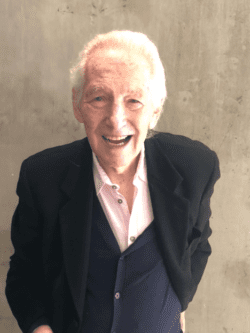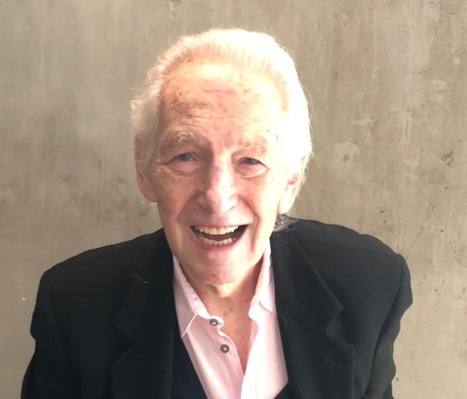“It is important to keep the stories alive. We survivors are all in our 80’s and 90’s. We aren’t going to be around for the next forty years…It is important for the next generation to know something about this.”
-Kurt Gutfreund
Kurt Gutfreund is an incredible man dedicated to keeping Holocaust survivors’ stories alive. His advocacy, generosity, and dedication to educating the next generation about World War II’s dark history is undeniably bringing light to a past that cannot be forgotten.
Roots
Kurt Gutfreund was born in Austria on January 6th, 1938. Two months after he was born, Hitler marched into Austria and annexed the country into Germany. It would remain part of Germany for the entirety of World War II.

One day in May of 1942 when Kurt and his mother were out and about, soldiers came and took his father. His father was sent to Maly Trostenets near Minsk in Belarus. German records that Kurt’s family later discovered indicated he was executed shortly after he arrived there.
Kurt and his mother went into hiding. Sadly, in December, Kurt and his mother were captured and taken to Theresienstadt, a concentration camp located in what is now the Czech Republic. He arrived at Theresienstadt on his fifth birthday. Kurt and his mother would spend the next two and a half years there, finding their freedom at the war’s end on May 8th, 1945.
Reflecting on life in the camp, Kurt recalls how resilient and innovative his mother was. One of her most brilliant survival mechanisms was a secret code she developed in letters she would send to Kurt’s aunt. Nazi soldiers would monitor what people in the concentration camps wrote in letters to loved ones. However, his mother discovered that they didn’t monitor what was written in the address section of each letter. It was in the singular top line of her addressed envelopes that Kurt’s mother would secure what they desired. Between his aunt’s first and last name, she would write in Viennese what they needed. Kurt remembers his mother got things like garlic and a little ball for him to play with through this incredibly innovative system.
Through letters and labor, Kurt’s mother secured their safety. His mother worked long hours at the camp and therefore was spared by the Nazis. When she wasn’t working, she taught him mathematics, reading and writing. Her dedication paid off, when they were liberated, Kurt entered school at the age appropriate grade level.
The death and grief at Theresienstadt can only be described as unfathomable and heartbreaking. Approximately 144,000 people were brought to the camp and a quarter of those people died of old age and from the bad conditions of the camp. Another 88,000 people were sent to the East and murdered. Out of the 15,000 children only 242 survived, Kurt considers himself one of the “lucky ones”. Kurt and his mother are a rare few that lived to tell the story of Theresienstadt. Amongst the few items they brought with them into freedom was his mother’s gold ring.
Kurt shared that upon entering the camp, everyone had to give the Nazis their money and belongings. His father was a goldsmith and crafted his mother’s gold wedding band himself. However, in order to save money he did not imprint the certification, he left it unmarked. When Kurt’s mother handed her ring to the officers upon their arrival, they examined it and said: “Give the woman her metal ring back.”
Around the camp, his mother tried to trade the gold ring for a loaf of bread or items they needed but nobody believed it was of any worth. Thus, his mother walked into camp with it on her finger, and left with it there too.
Recovery
With their few belongings and each other, Kurt and his mother began a new liberated life. In time, they received government supported housing. Kurt would remain in Austria and in school until age 14. After leaving traditional schooling, he apprenticed under an optician. As he learned the trade, he applied for a visa to the United States.
After waiting five years for the visa, Kurt moved to America and lived with his aunt who resided in Chicago, IL. She worked on State Street at a big department store. Through her connections, Kurt would land a job at another department store and over time work his way up from a sales clerk to an assistant buyer for their children’s division.
As it turns out, the apple doesn’t fall far from the tree. Kurt had inherited that innovative, savvy spirit his mother had. With an incredible ability to read the trends of the industry and navigate as a successful businessman, Kurt successfully took over a company and dominated the outerwear market in the midwest.
Renewal
Amidst his successful business endeavors, Kurt stayed in touch with his survivorship. In the 1980’s he was approached by the United States Holocaust Memorial Museum in Washington D.C.. Not only did he commit financially to contributing to the museum but he also gave them something of immeasurable value: the cards exchanged between his mother and aunt, all 100 of them. These rare letters are of immense value and are still housed in D.C. in temperature controlled vaults. 
When the Illinois Holocaust Museum & Education Center in Skokie, IL wanted to grow, Kurt stepped up to help them. Through advocacy and fundraising, Kurt has empowered the museum to grow to be the second largest Holocaust museum in the world. Kurt also speaks regularly at the museum, sharing his story and engaging with students from across the country. Kurt regularly invests in the D.C. and Skokie museums’ impact and has plans to give to the museums as part of his estate plan. He said generosity is an important part of the Jewish faith.
History gets a little further from us each and every day. However, there are pieces of the past that must never be forgotten. Stories that only few can still tell must be passed down from generation to generation. In listening and learning, we can honor those who were dealt some cards that humanity unjustly told to fold.
Kurt said that his mother’s gold ring is at home with him in Chicago and that perhaps his youngest daughter will use it as a wedding band one day. It has no inscription and its lack of markings carried it through Theresienstadt. Kurt is one of millions of Jewish people who were impacted by WWII. Just like that gold ring, Kurt is a little piece of history with a large legacy and a story that must be told from generation to generation.
If you are inspired to learn more about the Illinois Holocaust Museum & Education Center, please check out their website by clicking here. To check out the United States Holocaust Memorial Museum, click here.


